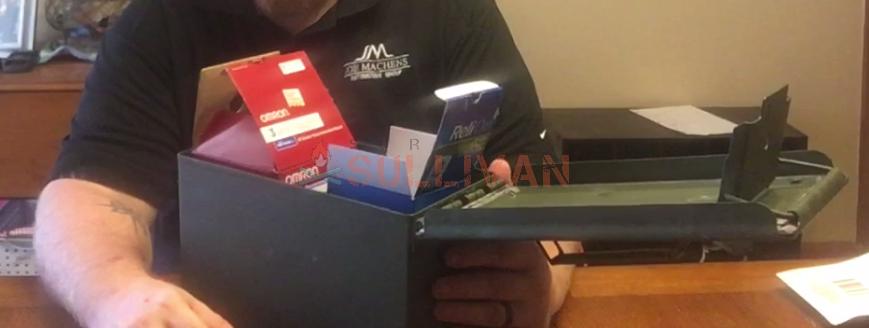Make a Simple Easy Faraday Cage With Aluminum Screen
One of the biggest concerns many preppers have is the threat of an EMP or electromagnetic pulse, which would bring the electrical grid crashing down around us, leaving us in the dark and the dark ages. If you have ever read William Forstchen's book One Second After, you'll know why.
An EMP is essentially a short, but very powerful burst of electromagnetic energy that will overload the power grid and any electronic device within its range, rendering them completely useless.
An EMP can occur due to natural or manmade causes, either due to a massive solar storm or the detonation of a nuclear device in upper atmosphere a few miles above the earth's surface.
If an EMP happened on a mass scale, you can bet that millions of people would die and those who survived would be thrown back to a life kind of like that of 200 years ago, but without the supports, knowledge, and skills in place to help them survive. William Forstchen is a historian whose book One Second After was mentioned on the floor of the U.S. congress as a book that every American should read because of the potential reality of the scenario.
The Wall Street Journal has reported on the possibility of an EMP attack on the U.S. and its allies. While there are many things you can do to prepare for an EMP, what we will discuss here is how to protect your most important electronic devices with the use of a Faraday cage.
What Is a Faraday Cage?
It's a container or box that is made of conductive material. It was first designed and built by scientist Michael Faraday in 1836 and its purpose is to protect whatever is inside the cage from electric fields.
When an electric field, such as an EMP, hits the cage, the free electrons in the conductive outer layer of the cage will realign themselves to block out the electric field trying to penetrate the cage. Since any electrical and computerized equipment would be rendered useless during an EMP, putting them inside a Faraday cage would protect them.
Now, we should clear something up. If you put a computer or tablet in a Faraday cage and an EMP occurred, they would function afterward.
However, that doesn't mean you'll be surfing the internet with them. Nor will you be able to plug them into the electrical outlet to charge them because everything else will have been fried by the EMP.
There will be no internet or cell phone service. There will be no electricity. For this reason, have a solar charger on hand, which will take care of the charging aspect of the problem.
Why Bother with Such a Cage?
If you can't use many devices because they can't fully function without an electrical grid or internet or cell phone service, then why bother protecting them? There are two primary reasons for this. First, is the all-important ability to communicate. In fact, communication is one of the most important things you will need after an EMP.
In a crisis, being able to gather and relay information can make the difference between life and death. You can put a ham radio, walkie talkies, and other types of radios in your simple Faraday cage to protect them and have a form of communication after an EMP. A ham or two-way radio doesn't depend on any service that won't function after an EMP.
The second reason to protect certain devices from an EMP is that even if you can't use the internet or phone service after an EMP, you can still store an enormous amount of data and information on a computer, tablet, or thumb drive, information you will need for EMP survival. With that in mind, let's take a look at the materials you will need to build your Faraday cage.
Supplies
Making a Faraday cage is very easy. It doesn't even have to be an actual cage. As long as it is a container that is made of conductive material and can completely enclose the items you want to protect, you will have an effective Faraday cage.
Before we get into the list of supplies you will need, know that even though many people say you can use Mylar bags and microwave ovens, these are not actually sufficiently effective to protect against electromagnetic pulses.
It turns out good old aluminum foil is the best choice, particularly if you need your Faraday cage to be easily portable. The list of items you need is short and these are not difficult items to gather.
You will need the following:
- Lots of heavy-duty aluminum foil (make sure you get the thick stuff!), or, even better, heavy-duty copper foil. Copper should be able to stop a stronger EMP.
- Plastic wrap, bags, or sheeting
- Pieces of cloth large enough to wrap around the items
- Cardboard boxes of various sizes
- Essential electrical items you won't need or want in the near future, but might need after the EMP strikes (your old cell phone, flashlights, walkie-talkie, radio etc)
- Galvanized trash can or an ammo box
Making the Cage
Now let's talk about what you will do with these items. Again, building a Faraday cage is very easy, but be sure you do it right and with care or your efforts will be for naught. Follow these steps to protect your electronics:
Step 1: Wrap all the items in cloth. You can actually put multiple items inside one cloth bag to save you time and material. Be sure that all the items are fully enclosed within the cloth.

Wrap the items in the plastic wrap, bags, or plastic sheeting. By adding this layer of plastic, you can help secure the electronic devices in the cloth, holding them in place and preventing any protruding or pointy part from sticking out. Use some bubble wrap too to make the entire Faraday shield shockproof.
Step 2: Now you will wrap the devices in your heavy duty aluminum foil. Wrap them around 2-3 times at least, for a thicker conductive layer:

Another way of doing the Faraday cage is to put everything inside an ammo can, and wrap that in aluminum foil for an even thicker conductive layer:

This is what the ammo can Faraday cage looks like after it's been further sealed with aluminum foil near the lid for extra safety:

The first type of cage is great for bug out bags, while the second one, because it's too heavy, so why not make but, just for the heck of it? You'll be able to fit more stuff into them, and save some money unless you want to o the "easy" route:
Getting a pre-made Faraday Bag
As an alternative you can use a faraday bag from amazon. If you are putting the devices into a galvanized trash can, then you need to either place them inside cardboard or line the galvanized trash can with cardboard. Whichever method you choose, the devices you are protecting must not come into contact with the exterior protective layer, i.e. the sides or bottom of the trash can or the outer layers of aluminum foil.
It is also possible to use a fine metal (such as aluminum) mesh and wooden posts to construct a cage. The same rules apply. Line the cage with cardboard or place your devices in a cardboard box before placing them inside the cage.
Other items that can be used in place of a galvanized trash can include a safe, a metal ammunition box, or any other metal container of any shape or size. Check out this video, which shows how to make a Faraday cage using a metal box.
DIY Faraday Cage
Grounding a Faraday Cage
There are varying opinions on whether or not a Faraday cage needs to be grounded. Some believe that the cage won't work if it is not grounded first. There are two things to consider when it comes to this aspect of Faraday cages. One is that grounding isn't mandatory for the cage to work. The Faraday cage does not need grounding to keep the electric field inside the container stable and protect whatever is inside it, provided there are no conductors (i.e. wires) entering the outer shield of the cage.
How to Test Your Faraday Cage
So how do you know if your Faraday cage actually works? You can test it using a radio. The range of frequencies from AM to FM will be adequate to test your cage. Turn the volume of the radio up high and turn it to a strong FM frequency. Then place the radio inside your Faraday cage and see if you can hear it. If you can't, that's great, but it doesn't necessarily mean your cage is working properly because it is relatively easy to block out FM frequencies.
With this in mind, AM frequencies are harder to block out, so take out your radio and tune it to a strong AM frequency. Then put it back into the cage and see if you can hear it. If you can, your Faraday cage isn't working, and if you can't hear it, then you have done a good job building your cage.
Additional Tips
Here are a few additional tips you need to know when building a Faraday cage and protecting your electronic devices:
- Be sure the edges of the cardboard lining a Faraday cage are overlapping and ensure that the closure of the metal container that forms the conductive outer layer is also overlapping and has no gaps. If there are any gaps, you need to cover these with aluminum foil or conductive tape.
- Take the batteries out of all devices if you can. This will prevent the devices from being ruined by battery acid leaking into them.
- Make two Faraday cages: a smaller, more portable one with some essential and basic electronics, such as your radio and walkie talkies, and make another larger one for other electronic items you will require later on.
- You can turn an entire room into a Faraday cage by covering the walls, floor, and ceiling with a fine wire mesh or a number of layers of aluminum foil and covering that with a non-conductive material, such as plywood. You would need a lot of aluminum foil to do this, so a Faraday room is probably not worth the effort for most people, when you can make several smaller Faraday cages and keep your devices there.
- A Faraday cage can have holes, but the size of the holes has to be smaller than the wavelength of electromagnetic energy you are trying to keep out. The best and safest Faraday cages are the ones that are made with solid metal, rather than a mesh. So, of for our purposes: no holes at all.
Final Word
Ultimately, you cannot protect everything from an EMP, and no matter what, you cannot totally preserve your way of life, but you can preserve a few devices that will help you adjust and cope better with the way life will be after an EMP hits.
Having the ability to communicate and access critical information and instructions will make a huge difference in a post-electronic world. Just remember, there is no guarantee that any Faraday cage will work in any given situation. After all, at this point in time, we haven't had a significant EMP event with which to test our Faraday cages. We can only build the best cages possible and hope for the best.
One last thing… a Faraday shield is just the tip of the iceberg of your EMP preparations. You'll need to learn to live without electricity, have a stockpile, means to defend yourself and, while you're at it, why not prepare for blackouts as well?
updated 11/13/2018
Source: https://www.survivalsullivan.com/build-faraday-cage/
Post a Comment for "Make a Simple Easy Faraday Cage With Aluminum Screen"